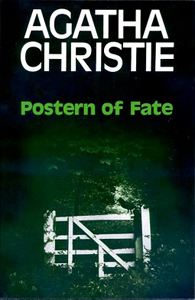I somewhat dreaded reading and reviewing “Postern of Fate” (1973), Agatha Christie’s last-written novel. It’s a popular choice as her worst book, and I feared I’d have to criticize writing done by an octogenarian with signs of dementia. After reading it, I’m happy to say it’s not her worst novel – “Passenger to Frankfurt” easily holds that title.
Indeed, parallels between the two novels make it easy to spot how “Passenger” is worse. Christie is again fascinated by global macro-politics and she approaches government spying worshipfully. But “Passenger” essentially has no main character; “Postern” has Tommy and Tuppence, now in their 70s and retired to the country town of Hollowquay.
I like reading their interplay. It’s comfortable and comforting. It’s like if you come upon your folks discussing something fairly insubstantial. There’s a danger you might tune them out, sure, but this is not painful to read, like “Passenger” is. (I’d also rate “The Big Four” lower. Although it has Poirot and Hastings, they aren’t in character there the way T&T are here.)

“Postern of Fate” (1973)
Author: Agatha Christie
Genre: Mystery, spy intrigue
Series: Tommy & Tuppence No. 5
Setting: Hollowquay, England, 1973
For the love of books
In “Postern of Fate,” the first topic the husband and wife discuss is their huge collection of books as they move into their fixer-upper country house. That topic will be catnip to 90 percent of people picking up this novel, deep into Christie’s catalog. In an old copy of Robert Louis Stevenson’s “The Black Arrow,” left there by the previous owner (but dating back to the owner before that), a child has left a code: “Mary Jordan did not die naturally. It was one of us.”
This is a good start, although Christie doesn’t do much with it. The pleasures are in Tuppence generally sticking her neck out too far in the local community as she interviews old-timers for clues, and in Tommy worrying about her.
As a solvable mystery, well, I don’t think Christie is even trying to write one; she’s more in her spy-games mode. But she’s never been as good at that stuff as she is at detection mysteries, and certainly that has not changed in this late-career period where her decreased mental faculties become apparent.
Editor needed
Also in this period of her career, she writes via audio dictation, and without anyone (herself or her publishing company) interested in improving the work in the editing stage, the results are shoddy. (A more positive spin would be to say this novel is impressive for being an off-the-cuff first draft.)
Parts that are unimportant to the plot are overwritten, and parts that are crucial to the plot are underwritten. Characters other than T&T never spark. The closest is Hannibal, their dog. I’m not criticizing “Postern” for having a dog be the best supporting character; it’s actually rather cute. And I’ve always loved the way Christie writes pets like they are sort of human, translating their noises and behaviors into English. (See also “Dumb Witness.”)

The problem is that Hannibal is only there when he’s doing something. The rest of the time he’s off page. This doesn’t fit with his personality. If he were by T&T’s side every time they were in the house, even if it’s just a brief mention like Tuppence reaching over and petting the unusually relaxed dog, “Postern” would have more realism.
Reflections on Tommy & Tuppence
As this is the fifth and final T&T book, we can reflect on their legacy. They are loved by some Christie fans, dismissed by others – and that mixed response is exactly right. Christie herself is only mildly engaged with them; here, she outright forgets about “By the Pricking of My Thumbs” (T&T’s fourth book) when Tuppence gets excited about the Mary Jordan mystery being their supposedly first cold case.
Also, Christie decides T&T are regionally famous for the “N or M?” case (their third book) – a convoluted uncovering of a German spy during WWII. But I think it’s much more likely they’d be famous for “Thumbs,” because that features the uncovering of a juicy drug-selling enterprise and skeletons bricked up in creepy country houses.
A substantial segment of Christie fans considers the new Poirot and Marple books by other authors to automatically be faux-Poirot and make-believe-Marple. That’s understandable. No one can have the Christie touch like Christie herself.
But I’d contend that further Tommy and Tuppence adventures – perhaps in a TV series – could be palatable and fun, built on the couple bantering, like those old “Thin Man” movies. None of the five T&T books rank among Christie’s elites, yet I admit I am much more in the camp of liking the duo than disliking them. And I still have questions about them: Is spycraft the only job they’ve held? It seems like they stumble into things too much to be considered pros at this job.
None of the T&T plots are all that great or sensible; indeed, “Postern of Fate” barely has a plot. It just has vague intrigue about the distant past. That said, Tommy and Tuppence – and Hannibal – had me turning the pages without much dread. For that, I’m rather relieved.
Sleuthing Sunday reviews an Agatha Christie book or adaptation. Click here to visit our Agatha Christie Zone.

